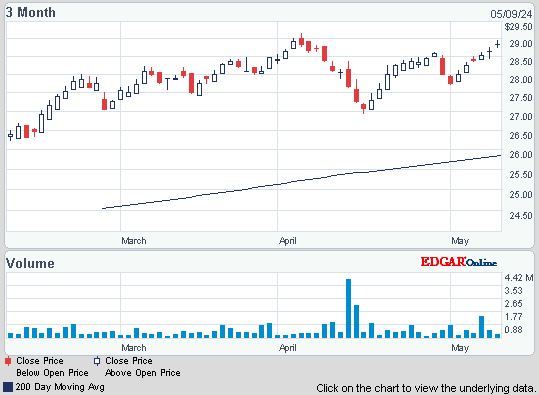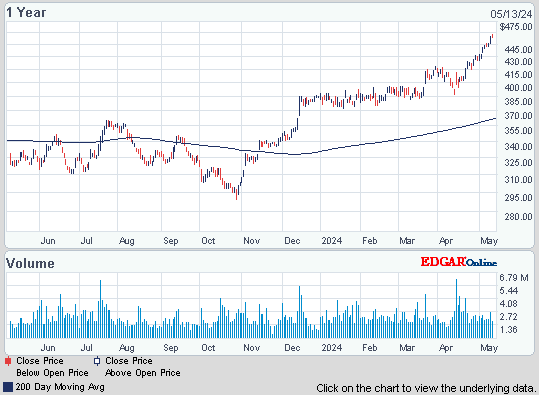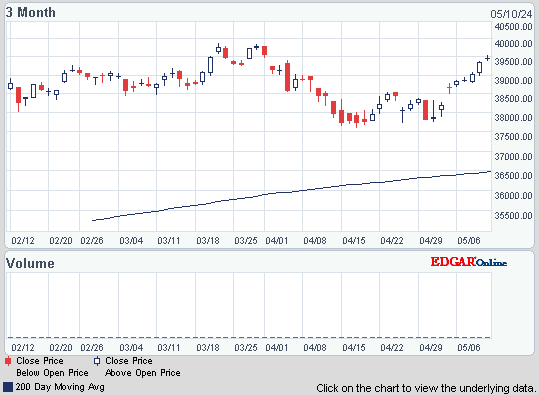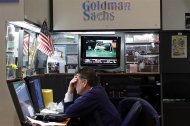Dow rose 54, advancers over decliners 5-2 & NAZ went up 22. Bank stocks continue to rise, taking the Financial Index up 1+ to 186 & not far from the 189 late Oct highs.
The MLP index was up a fraction in in the 391s & the REIT index rose 2+ to 238. Junk bond funds were little changed as were Treasuries. There are plenty of risk averse investors as the yield on the 10 year Treasury remains in low territory, below 1.9%. Oil remains above $100 & gold continues to show strength as it has all month.


US factory output rose in Dec by the most in year. Stronger demand for business equipment, vehicles & energy offered visible evidence that manufacturing has roared back from the depths of the recession. The Federal Reserve said that manufacturing increased 0.9%, the biggest gain in 12 months. Overall output of the factories, mines & utilities grew 0.4%. But warm weather dampened demand for energy produced by utilities. Industrial output is less than 5% below its pre-recession peak, reached in Sep 2007 & has increased more than 14% since hitting a recession low in Jun 2009 & remains nearly 8% below its pre-recession peak in Jul 2007. Factories benefited in H2 from a number of trends. Consumers bought more cars, businesses boosted spending on industrial machinery and computers & companies are restocking warehouses after cutting inventories over the summer. Still, Europe's debt crisis has already started to dampen demand for American exports which could slow manufacturing & threaten growth in the 2012.
U.S. Industrial Production Rose 0.4%

Christine Lagarde
Photo: Bloomberg
The IMF is aiming to increase its financial firepower by $500B so it can give out new loans to help mitigate a worsening financial crisis. It estimates that countries around the world will need about $1T in loans over the coming years & most of the concerns center on the eurozone, which has been embroiled in a debt crisis for 2 years. "At this preliminary stage, we are exploring options on funding and will have no further comment until the necessary consultations with the Fund's membership have been completed," an IMF spokesman said. After $200B that European countries have recently promised, it is already more than one third on its way to reaching its fund-raising goal. The IMF has put up about a third of the financing of the eurozone's bailouts, but there are growing worries that non-European countries will also need more help given the worsening economic outlook. Earlier, its sister organization, the World Bank, urged emerging countries that they have to be ready for a severe global downturn if the crisis in the eurozone intensifies. The eurozone, in particular, has been pushing countries around the globe to give more funds to the IMF in the hope that it would build up a larger firewall to stop the continent's debt troubles from spreading to large economies like Spain, Italy or even France. But so far, even countries relatively flush with cash as China or Brazil have been reluctant to put up more money for Europe. The US is also reluctant to increase the fund's resources. Big daddy for bailouts may have to be more cautious about lending in the future.
Photo: Yahoo
Goldman Sachs Q4 profit fell 56% as trading & investment banking revenue plunged, but the bank managed to beat expectations thru cost cutting & lower taxes. CFO Viniar said GS is targeting $1.4B in annual cost savings, up from an earlier goal of $1.2B, & has a "small amount" left to do in 2012. Viniar also said profit growth must come from higher revenue & not cost cuts. But he added that GS was investing in operations at a "more moderate pace" due to a weak business environment. Its payroll declined 2400 during the year, reflecting job cuts across trading, banking & back-office operations. The bank slashed compensation 21% to $12.2B, or $367K per employee, from $15.4B, or $430K per employee, in 2010. Keep in mind that these employees were in the top 1% who were supposed to pay more in taxes to help the US balance its books! The stock liked the news, gaining 4.94 (5%).
Goldman Sachs Profit Drops 58%

The news today was reasonably good. Rising factory output is what the economy needs,although it's not very helpful for the depressed housing industry. Giving the IMF more money for bailouts is more difficult to evaluate. The big boys, like US, China, India, are not anxious to toss their money around, so reaching the goal of $½T could require a lot of selling around the world. And that raises the question about throwing good money after bad. Bank earnings have not been great. The biggies are expected to have mixed results with explanations about poorly performing divisions along with announcements of more layoffs to reduce costs. Industrial & service companies will be reporting in the next couple of days.

The MLP index was up a fraction in in the 391s & the REIT index rose 2+ to 238. Junk bond funds were little changed as were Treasuries. There are plenty of risk averse investors as the yield on the 10 year Treasury remains in low territory, below 1.9%. Oil remains above $100 & gold continues to show strength as it has all month.
JPMorgan Chase Capital XVI (AMJ
Treqasury yields:
U.S. 3-month | 0.025% | |
U.S. 2-year | 0.222% | |
U.S. 10-year | 1.860% |
| CLG12.NYM | ...Crude Oil Feb 12 | ...100.81 ... | (0.1%) |
| GCF12.CMX | ...Gold Jan 12 | ........1,657.80 | .... | (0.2%) |
Today's 50 Top Trending Stocks below:
Click below for the latest market update:

Photo: Bloomberg
US factory output rose in Dec by the most in year. Stronger demand for business equipment, vehicles & energy offered visible evidence that manufacturing has roared back from the depths of the recession. The Federal Reserve said that manufacturing increased 0.9%, the biggest gain in 12 months. Overall output of the factories, mines & utilities grew 0.4%. But warm weather dampened demand for energy produced by utilities. Industrial output is less than 5% below its pre-recession peak, reached in Sep 2007 & has increased more than 14% since hitting a recession low in Jun 2009 & remains nearly 8% below its pre-recession peak in Jul 2007. Factories benefited in H2 from a number of trends. Consumers bought more cars, businesses boosted spending on industrial machinery and computers & companies are restocking warehouses after cutting inventories over the summer. Still, Europe's debt crisis has already started to dampen demand for American exports which could slow manufacturing & threaten growth in the 2012.
U.S. Industrial Production Rose 0.4%

Photo: Bloomberg
The IMF is aiming to increase its financial firepower by $500B so it can give out new loans to help mitigate a worsening financial crisis. It estimates that countries around the world will need about $1T in loans over the coming years & most of the concerns center on the eurozone, which has been embroiled in a debt crisis for 2 years. "At this preliminary stage, we are exploring options on funding and will have no further comment until the necessary consultations with the Fund's membership have been completed," an IMF spokesman said. After $200B that European countries have recently promised, it is already more than one third on its way to reaching its fund-raising goal. The IMF has put up about a third of the financing of the eurozone's bailouts, but there are growing worries that non-European countries will also need more help given the worsening economic outlook. Earlier, its sister organization, the World Bank, urged emerging countries that they have to be ready for a severe global downturn if the crisis in the eurozone intensifies. The eurozone, in particular, has been pushing countries around the globe to give more funds to the IMF in the hope that it would build up a larger firewall to stop the continent's debt troubles from spreading to large economies like Spain, Italy or even France. But so far, even countries relatively flush with cash as China or Brazil have been reluctant to put up more money for Europe. The US is also reluctant to increase the fund's resources. Big daddy for bailouts may have to be more cautious about lending in the future.
Photo: Yahoo
Goldman Sachs Q4 profit fell 56% as trading & investment banking revenue plunged, but the bank managed to beat expectations thru cost cutting & lower taxes. CFO Viniar said GS is targeting $1.4B in annual cost savings, up from an earlier goal of $1.2B, & has a "small amount" left to do in 2012. Viniar also said profit growth must come from higher revenue & not cost cuts. But he added that GS was investing in operations at a "more moderate pace" due to a weak business environment. Its payroll declined 2400 during the year, reflecting job cuts across trading, banking & back-office operations. The bank slashed compensation 21% to $12.2B, or $367K per employee, from $15.4B, or $430K per employee, in 2010. Keep in mind that these employees were in the top 1% who were supposed to pay more in taxes to help the US balance its books! The stock liked the news, gaining 4.94 (5%).
Goldman Sachs Profit Drops 58%
Goldman Sachs Group, Inc. (The) (GS)
The news today was reasonably good. Rising factory output is what the economy needs,although it's not very helpful for the depressed housing industry. Giving the IMF more money for bailouts is more difficult to evaluate. The big boys, like US, China, India, are not anxious to toss their money around, so reaching the goal of $½T could require a lot of selling around the world. And that raises the question about throwing good money after bad. Bank earnings have not been great. The biggies are expected to have mixed results with explanations about poorly performing divisions along with announcements of more layoffs to reduce costs. Industrial & service companies will be reporting in the next couple of days.
Dow Industrials
Get your favorite symbols' Trend Analysis TODAY!!!



No comments:
Post a Comment